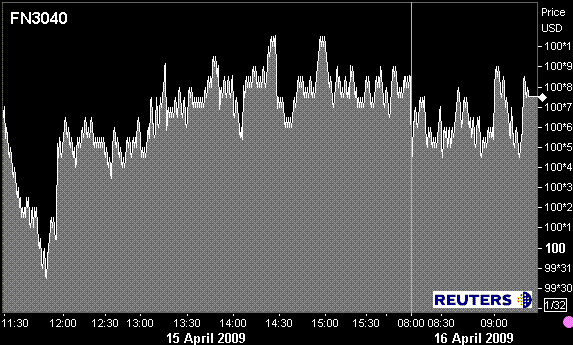Asian markets had mixed reactions to China's release of GDP data overnight. China reported its economy grew at a pace of 6.1% vs. 6.8% in the previous quarter. Analysts were expecting the economy to grow at 6.3%. Although data was "worse than expected" and China's slowest quarter of growth since records began being kept in 1992....markets did not totally panic as the world's third largest economy appears to be taking well to the government's $585 stimulus package. Concerns, however, do remain due do the fact that China's economy is heavily dependent on global export demand which continues to diminish.
In Tokyo the NIKKEI moved marginally higher while the TOPIX traded lower. In Hong Kong the HANG SENG INDEX moved 0.55% to the downside while further north in Shanghai the SSE Composite was down 0.87%. In Europe the FTSE , DJ STOXX, the CAC, DAX, S&P/MIB, etc etc all traded to the upside following better than expected earnings from JP Morgan Chase and a small sign of recovery in auto sales .
Consequently TSY yields moved higher overnight as global market participants showed some conviction for riskier assets. The yield curve is slightly steeper at the moment...2s vs.10s at 190.5bps. So far this morning rate sheet influential MBS prices have bounced around a tight range with a slight bias towards lower dollar priced MBS coupons. Depending on your benchmark of choice...MBS/TSY yield spreads are slightly tighter compared to 3pm closing marks.
Since 5pm "Going Out" Marks....
FN30_______________________________
FN 4.0 -------->>>> +0-00 to 100-08 from 100-08
FN 4.5 -------->>>> +0-00 to 102-01 from 102-01
FN 5.0 -------->>>> +0-00 to 103-08 from 103-08
FN 5.5 -------->>>> +0-00 to 104-03 from 104-03
FN 6.0 -------->>>> +0-00 to 104-28 from 104-28
GN30________________________________
GN 4.0 -------->>>> +0-00 to 100-15 from 100-15
GN 4.5 -------->>>> +0-00 to 102-11 from 102-11
GN 5.0 -------->>>> -0-01 to 103-27 from 103-28
GN 5.5 -------->>>> +0-00 to 104-12 from 104-12
GN 6.0 -------->>>> +0-00 to 104-26 from 104-26

EFFECTIVE FED FUNDS: +0.00 to 0.16 from 0.16
LIBOR FIXINGS
O/N LIBOR: -0.0125 to 0.2500 from 0.2625
1 MONTH: -0.0012 to 0.4469 from 0.4481
3 MONTH: -0.0056 to 1.1069 from 1.1125
6 MONTH: -0.0063 to 1.6406 from 1.6469
1 YEAR: -0.0063 to 1.9063 from 1.9125
It has been a slow week in mortgage world following Class A settlement and Class C allocation/notification, not to mention many are enjoying extended holidays. Mortgage bankers did however do some profit taking of their own yesterday. Originators will be more likely to protect their production pipelines from interest rate risk when MBS prices reach the topside of their range (for the same reason you lock when YSP is high)...unfortunately as Matt pointed out yesteday....more supply of MBS generally implies lower MBS dollar prices and a higher probability for "reprice for the worse" alerts.
Yesterday this was however not the case....mortgage banker' supply surpassed the $6bn mark yet the MBS market remained relatively stable. This leads us to believe that more market participants are beginning to move"down in coupon" towards "prepay protected" positions because either the MBS market is getting too rich or there is small shift in sentiment towards more protected cash flows. I am more apt to believe in the prior vs. the latter given the Federal Reserve is providing funding for the "low supply" side of the stack (day trading coupons). Remember: the Fed has been selling "the Roll" to market participants who have been paper trading/day trading in the "up in coupon" side of the stack.
This is not much concern for your rate sheet coupons though...the Fed continues to keep volatility low (lack of convexity hedging) for mortgage originators looking to protect their pipeline from interest rate risk. At the moment the primary market (loan officers and borrowers) are seeing record low rates because of the government provided support and liquidity....the debate, however, remains as to whether or not lender's will pass through YSP to loan officers looking to reduce consumer borrowing costs. Several arguments have been presented...unfortunately common logic does not apply given existing primary market inefficiencies.





